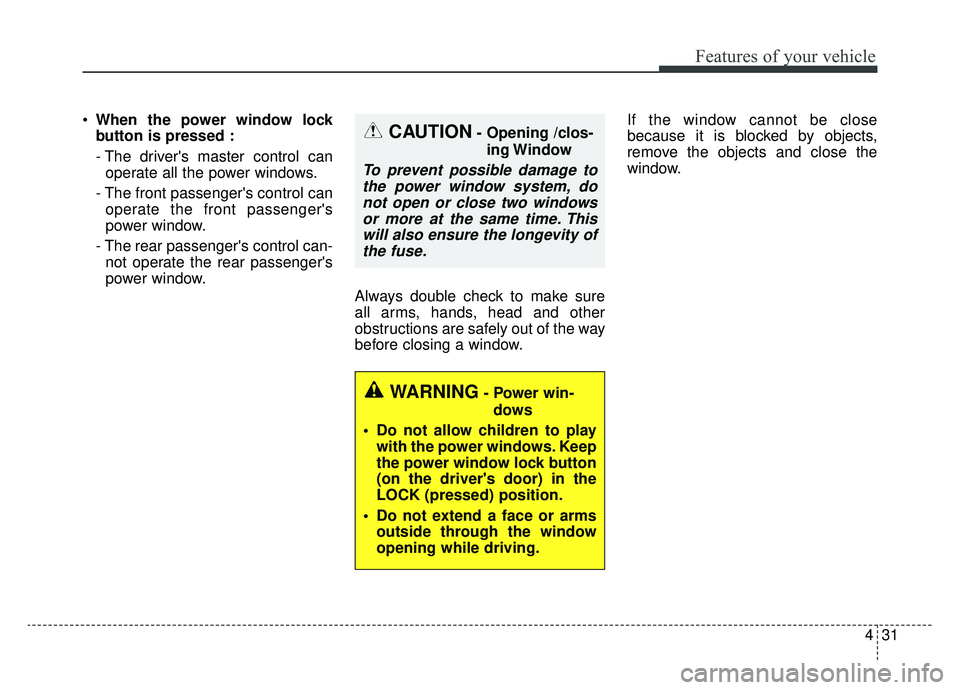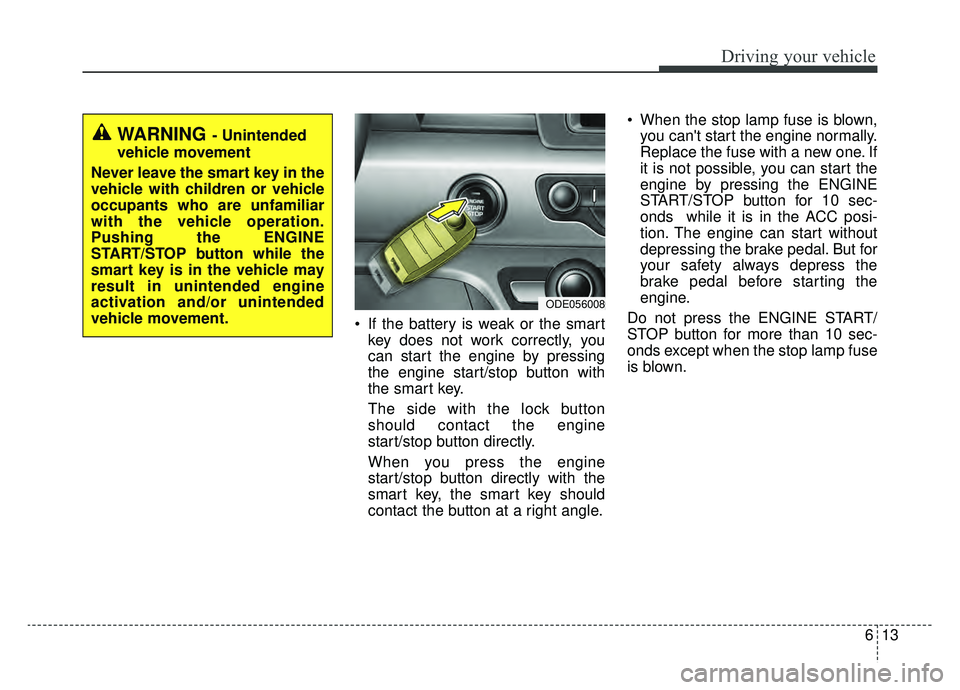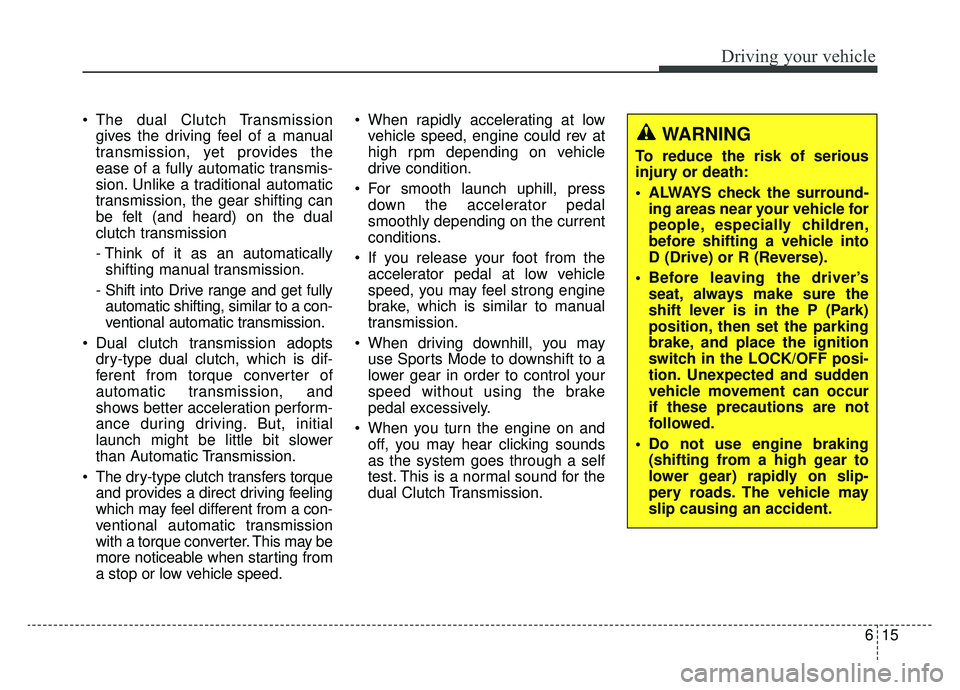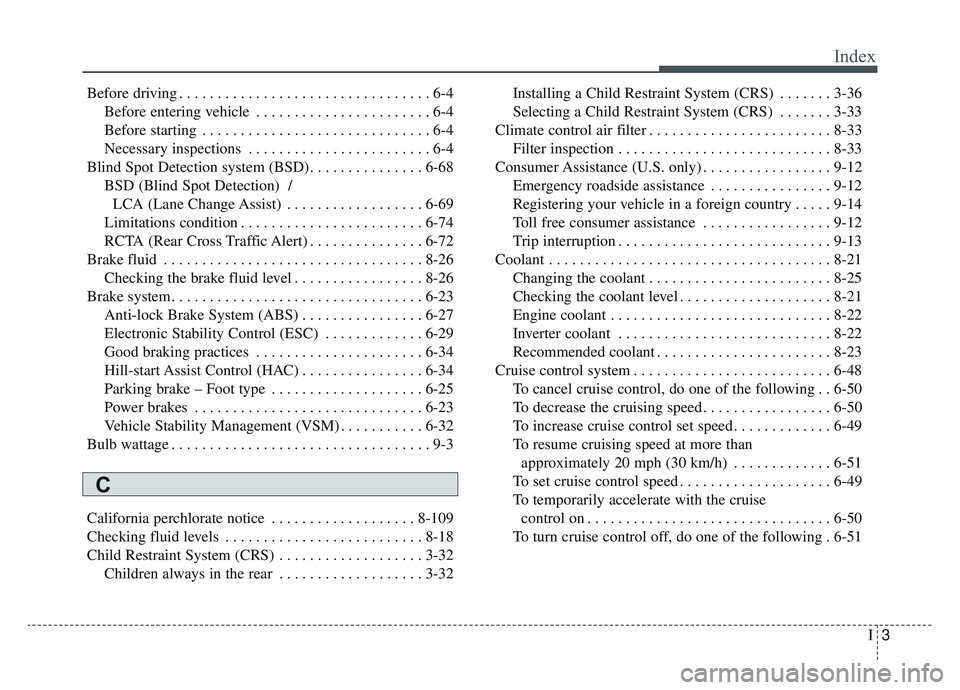2019 KIA NIRO HYBRID EV child lock
[x] Cancel search: child lockPage 166 of 611

431
Features of your vehicle
When the power window lock
button is pressed :
- The driver's master control can
operate all the power windows.
- The front passenger's control can operate the front passenger's
power window.
- The rear passenger's control can- not operate the rear passenger's
power window.
Always double check to make sure
all arms, hands, head and other
obstructions are safely out of the way
before closing a window. If the window cannot be close
because it is blocked by objects,
remove the objects and close the
window.CAUTION- Opening /clos-
ing Window
To prevent possible damage tothe power window system, donot open or close two windowsor more at the same time. Thiswill also ensure the longevity ofthe fuse.
WARNING- Power win-
dows
Do not allow children to play with the power windows. Keep
the power window lock button
(on the driver's door) in the
LOCK (pressed) position.
Do not extend a face or arms outside through the window
opening while driving.
Page 349 of 611

613
Driving your vehicle
If the battery is weak or the smartkey does not work correctly, you
can start the engine by pressing
the engine start/stop button with
the smart key.
The side with the lock button
should contact the engine
start/stop button directly.
When you press the engine
start/stop button directly with the
smart key, the smart key should
contact the button at a right angle. When the stop lamp fuse is blown,
you can't start the engine normally.
Replace the fuse with a new one. If
it is not possible, you can start the
engine by pressing the ENGINE
START/STOP button for 10 sec-
onds while it is in the ACC posi-
tion. The engine can start without
depressing the brake pedal. But for
your safety always depress the
brake pedal before starting the
engine.
Do not press the ENGINE START/
STOP button for more than 10 sec-
onds except when the stop lamp fuse
is blown.
WARNING - Unintended
vehicle movement
Never leave the smart key in the
vehicle with children or vehicle
occupants who are unfamiliar
with the vehicle operation.
Pushing the ENGINE
START/STOP button while the
smart key is in the vehicle may
result in unintended engine
activation and/or unintended
vehicle movement.
ODE056008
Page 351 of 611

615
Driving your vehicle
The dual Clutch Transmissiongives the driving feel of a manual
transmission, yet provides the
ease of a fully automatic transmis-
sion. Unlike a traditional automatic
transmission, the gear shifting can
be felt (and heard) on the dual
clutch transmission
- Think of it as an automaticallyshifting manual transmission.
- Shift into Drive range and get fully automatic shifting, similar to a con-
ventional automatic transmission.
Dual clutch transmission adopts dry-type dual clutch, which is dif-
ferent from torque converter of
automatic transmission, and
shows better acceleration perform-
ance during driving. But, initial
launch might be little bit slower
than Automatic Transmission.
The dry-type clutch transfers torque and provides a direct driving feeling
which may feel different from a con-
ventional automatic transmission
with a torque converter. This may be
more noticeable when starting from
a stop or low vehicle speed. When rapidly accelerating at low
vehicle speed, engine could rev at
high rpm depending on vehicle
drive condition.
For smooth launch uphill, press down the accelerator pedal
smoothly depending on the current
conditions.
If you release your foot from the accelerator pedal at low vehicle
speed, you may feel strong engine
brake, which is similar to manual
transmission.
When driving downhill, you may use Sports Mode to downshift to a
lower gear in order to control your
speed without using the brake
pedal excessively.
When you turn the engine on and off, you may hear clicking sounds
as the system goes through a self
test. This is a normal sound for the
dual Clutch Transmission.
WARNING
To reduce the risk of serious
injury or death:
ALWAYS check the surround-ing areas near your vehicle for
people, especially children,
before shifting a vehicle into
D (Drive) or R (Reverse).
Before leaving the driver’s seat, always make sure the
shift lever is in the P (Park)
position, then set the parking
brake, and place the ignition
switch in the LOCK/OFF posi-
tion. Unexpected and sudden
vehicle movement can occur
if these precautions are not
followed.
Do not use engine braking (shifting from a high gear to
lower gear) rapidly on slip-
pery roads. The vehicle may
slip causing an accident.
Page 602 of 611

I3
Index
Before driving . . . . . . . . . . . . . . . . . . . . . . . . . . . . . . . . . 6-4Before entering vehicle . . . . . . . . . . . . . . . . . . . . . . . 6-4
Before starting . . . . . . . . . . . . . . . . . . . . . . . . . . . . . . 6-4
Necessary inspections . . . . . . . . . . . . . . . . . . . . . . . . 6-4
Blind Spot Detection system (BSD). . . . . . . . . . . . . . . 6-68 BSD (Blind Spot Detection) /LCA (Lane Change Assist) . . . . . . . . . . . . . . . . . . 6-69
Limitations condition . . . . . . . . . . . . . . . . . . . . . . . . 6-74
RCTA (Rear Cross Traffic Alert) . . . . . . . . . . . . . . . 6-72
Brake fluid . . . . . . . . . . . . . . . . . . . . . . . . . . . . . . . . . . 8-26\
Checking the brake fluid level . . . . . . . . . . . . . . . . . 8-26
Brake system. . . . . . . . . . . . . . . . . . . . . . . . . . . . . . . . . 6-23 Anti-lock Brake System (ABS) . . . . . . . . . . . . . . . . 6-27
Electronic Stability Control (ESC) . . . . . . . . . . . . . 6-29
Good braking practices . . . . . . . . . . . . . . . . . . . . . . 6-34
Hill-start Assist Control (HAC) . . . . . . . . . . . . . . . . 6-34
Parking brake – Foot type . . . . . . . . . . . . . . . . . . . . 6-25
Power brakes . . . . . . . . . . . . . . . . . . . . . . . . . . . . . . 6-23
Vehicle Stability Management (VSM) . . . . . . . . . . . 6-32
Bulb wattage . . . . . . . . . . . . . . . . . . . . . . . . . . . . . . . . . . 9-3
California perchlorate notice . . . . . . . . . . . . . . . . . . . 8-109
Checking fluid levels . . . . . . . . . . . . . . . . . . . . . . . . . . 8-18
Child Restraint System (CRS) . . . . . . . . . . . . . . . . . . . 3-32 Children always in the rear . . . . . . . . . . . . . . . . . . . 3-32 Installing a Child Restraint System (CRS) . . . . . . . 3-36
Selecting a Child Restraint System (CRS) . . . . . . . 3-33
Climate control air filter . . . . . . . . . . . . . . . . . . . . . . . . 8-33 Filter inspection . . . . . . . . . . . . . . . . . . . . . . . . . . . . 8-33
Consumer Assistance (U.S. only) . . . . . . . . . . . . . . . . . 9-12 Emergency roadside assistance . . . . . . . . . . . . . . . . 9-12
Registering your vehicle in a foreign country . . . . . 9-14
Toll free consumer assistance . . . . . . . . . . . . . . . . . 9-12
Trip interruption . . . . . . . . . . . . . . . . . . . . . . . . . . . . 9-13
Coolant . . . . . . . . . . . . . . . . . . . . . . . . . . . . . . . . . . . . \
. 8-21 Changing the coolant . . . . . . . . . . . . . . . . . . . . . . . . 8-25
Checking the coolant level . . . . . . . . . . . . . . . . . . . . 8-21
Engine coolant . . . . . . . . . . . . . . . . . . . . . . . . . . . . . 8-22
Inverter coolant . . . . . . . . . . . . . . . . . . . . . . . . . . . . 8-22
Recommended coolant . . . . . . . . . . . . . . . . . . . . . . . 8-23
Cruise control system . . . . . . . . . . . . . . . . . . . . . . . . . . 6-48 To cancel cruise control, do one of the following . . 6-50
To decrease the cruising speed . . . . . . . . . . . . . . . . . 6-50
To increase cruise control set speed . . . . . . . . . . . . . 6-49
To resume cruising speed at more thanapproximately 20 mph (30 km/h) . . . . . . . . . . . . . 6-51
To set cruise control speed . . . . . . . . . . . . . . . . . . . . 6-49
To temporarily accelerate with the cruise control on . . . . . . . . . . . . . . . . . . . . . . . . . . . . . . . . 6-50
To turn cruise control off, do one of the following . 6-51
C
Page 603 of 611

Index
4I
Defroster . . . . . . . . . . . . . . . . . . . . . . . . . . . . . . . . . . . 4-\
129Rear window defroster . . . . . . . . . . . . . . . . . . . . . . 4-129
Dimensions . . . . . . . . . . . . . . . . . . . . . . . . . . . . . . . . . . . 9-\
2
Door locks. . . . . . . . . . . . . . . . . . . . . . . . . . . . . . . . . . . 4-\
20 Child-protector rear door lock . . . . . . . . . . . . . . . . . 4-23
Operating door locks from inside the vehicle . . . . . 4-21
Operating door locks from outside the vehicle . . . . 4-20
Driver Attention Alert system (DAA). . . . . . . . . . . . . . 6-84 Resetting the system . . . . . . . . . . . . . . . . . . . . . . . . 6-86
System disabled . . . . . . . . . . . . . . . . . . . . . . . . . . . . 6-86
System malfunction . . . . . . . . . . . . . . . . . . . . . . . . . 6-86
System setting and activation . . . . . . . . . . . . . . . . . . 6-84
Dual Clutch Transmission (DCT). . . . . . . . . . . . . . . . . 6-14 Dual Clutch Transmission operation . . . . . . . . . . . . 6-14
Good driving practices . . . . . . . . . . . . . . . . . . . . . . . 6-21
Economical operation . . . . . . . . . . . . . . . . . . . . . . . . . . 6-89
Electrical Equipment (U.S. only) . . . . . . . . . . . . . . . . . 9-15 Installation of a mobile two-way radio system . . . . 9-15
Emergency starting . . . . . . . . . . . . . . . . . . . . . . . . . . . . . 7-5 Before jump starting (for Hybrid) . . . . . . . . . . . . . . . 7-5
Jump starting . . . . . . . . . . . . . . . . . . . . . . . . . . . . . . . 7-7
Method to disconnect the (-) cable for regularmaintenance (For Hybrid) . . . . . . . . . . . . . . . . . . . . 7-7 Push-starting . . . . . . . . . . . . . . . . . . . . . . . . . . . . . . . . 7-9
Emission control system . . . . . . . . . . . . . . . . . . . . . . . 8-106 Crankcase emission control system . . . . . . . . . . . . 8-106
Evaporative emission control(Including ORVR :Onboard Refueling Vapor Recovery) system. . . . 8-106
Exhaust emission control system . . . . . . . . . . . . . . 8-107
Engine . . . . . . . . . . . . . . . . . . . . . . . . . . . . . . . . . . . . \
. . . 9-2
Engine clutch actuator fluid . . . . . . . . . . . . . . . . . . . . . 8-27 Checking the engine clutch actuator fluid level. . . . 8-27
Engine compartment . . . . . . . . . . . . . . . . . . . . . . . . 2-6, 8-3
Engine number . . . . . . . . . . . . . . . . . . . . . . . . . . . . . . . 9-10
Engine oil . . . . . . . . . . . . . . . . . . . . . . . . . . . . . . . . . . . 8-\
19 Changing the engine oil and filter . . . . . . . . . . . . . . 8-20
Checking the engine oil level . . . . . . . . . . . . . . . . . . 8-19
Engine start/stop button . . . . . . . . . . . . . . . . . . . . . . . . . 6-9 Engine start/stop button position . . . . . . . . . . . . . . . . 6-9
Illuminated engine start/stop button. . . . . . . . . . . . . . 6-9
Starting the hybrid system . . . . . . . . . . . . . . . . . . . . 6-11
Explanation of scheduled maintenance items . . . . . . . 8-15
Exterior features . . . . . . . . . . . . . . . . . . . . . . . . . . . . . 4-165 Roof rack . . . . . . . . . . . . . . . . . . . . . . . . . . . . . . . . 4-165
Exterior overview . . . . . . . . . . . . . . . . . . . . . . . . . . . . . . 2-2
Folding key . . . . . . . . . . . . . . . . . . . . . . . . . . . . . . . . . . . 4-\
4 Battery replacement . . . . . . . . . . . . . . . . . . . . . . . . . . 4-7
Immobilizer system . . . . . . . . . . . . . . . . . . . . . . . . . . 4-8
E
D
F